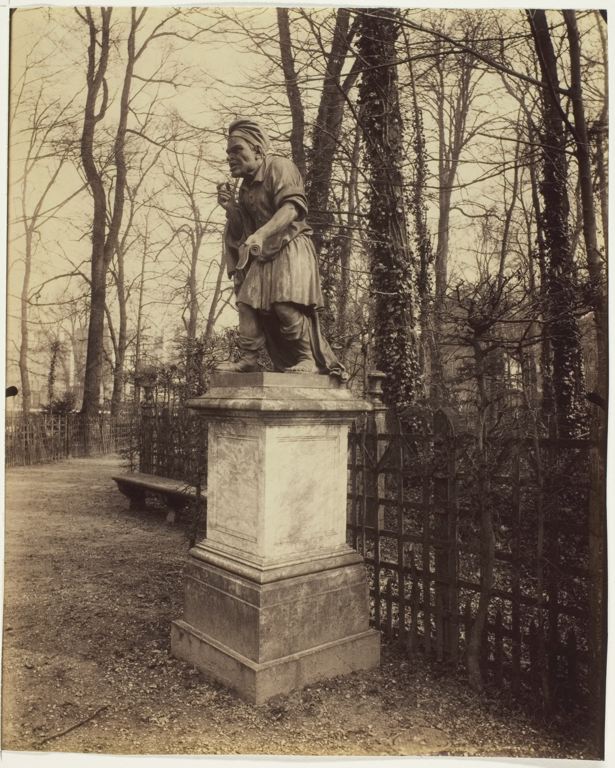
La Terre by Massou, Versailles. (Metropolitan Museum of Art, Wikimedia Commons)
Towards the end of his life, photographer Eugène Atget made repeated journeys from his home in Paris to the palace of Versailles. His photographs of the gardens, in particular their sculpture and ornaments, evoke a strong sense of the unique atmosphere of this place in the 1920s.
People are noticeably absent in Atget’s Versailles, giving the gardens a slightly mysterious feel. But closer inspection shows a flower bed has been stripped out and awaits new planting – suggesting that gardeners have recently been at work here. And what of the abandoned chairs which frequently appear next to the statues? The sculptures form a strange but intriguing juxtaposition with these domestic scale chairs, and Atget seems content to leave the chairs randomly placed, as he finds them, allowing them to suggest a narrative. Who last sat here? And how did one of the chairs come to be overturned?
Atget’s photographs also explore the relationship between the sculptures and their background of trellis and foliage. In summer, the whiteness of the stone looks crisp against a dark background of leaves, but against the natural shapes of the bare winter trees the sculptures start to seem less confident in their setting, and secondary to nature. The monumental Arc de Triomphe, celebrating France’s victories in battle, looks melancholy covered in autumn leaves, the face of one of the heroes cast in almost total shadow.
A pioneer of documentary photography, Eugène Atget (1857 – 1927) is best known for his photographic survey of the rapidly disappearing streets of old Paris, as swathes of the city were re-developed by Haussmann in the 19th century. Trained as an actor, he explored a career as a painter, but eventually took up photography in the 1880s. In the early 1920s he became financially independent after selling thousands of his negatives, and so was able to pursue personal photographic projects.
Atget referred to his photographs as ‘documents’ and marketed his services to artists, providing location views of landscapes and buildings – useful source material to plan angles and perspectives. To some extent, this explains the emotional detachment in his work, and the emphasis on the subject rather than the creator. A rare biographical photograph of his studio shows ordered shelves housing the equipment and paraphernalia of his trade, but little suggestion as to the character of the man himself.
Atget’s detached style seems appropriate for Versailles, faithfully recording its scale and grandeur, but sometimes in the details revealing tensions and doubts, introducing a counter-narrative to the royal wealth and power on display.
More information about Eugène Atget and his work in the links below:

(Metropolitan Museum of Art, Wikimedia Commons)

(Metropolitan Museum of Art, Wikimedia Commons)

(Metropolitan Museum of Art, Wikimedia Commons)

(Metropolitan Museum of Art, Wikimedia Commons)

Bassin de Midi, Versailles. (Wikimedia Commons)

Steps next to the Orangery, Versailles. (Metropolitan Museum of Art, Wikimedia Commons)

(Wikimedia Commons)

Grille du Chateau, Versailles (Wikimedia Commons)

Ironwork from Le Grand Trianon, Versailles (Wikimedia Commons)

Le Grand Trianon, Versailles (Metropolitan Museum of Art, Wikimedia Commons)

Le Petit Trianon, Versailles (Yale University Art Gallery, Wikimedia Commons)

(Wikimedia Commons)

Coin de Parc, Versailles. (Wikimedia Commons)

Coin de Parc, Versailles (Wikimedia Commons)

Bosquet de l’Arc de Triomphe, Versailles (Wikimedia Commons)

Bosquet de l’Arc de triomphe by sculptors Coysevox, Tuby and Prou (Wikimedia Commons)

Cour du Parc, Versailles. (Metropolitan Museum of Art)

Atget’s studio with contact print frames (Metropolitan Museum of Art, Wikimedia Commons)
Further Reading:
